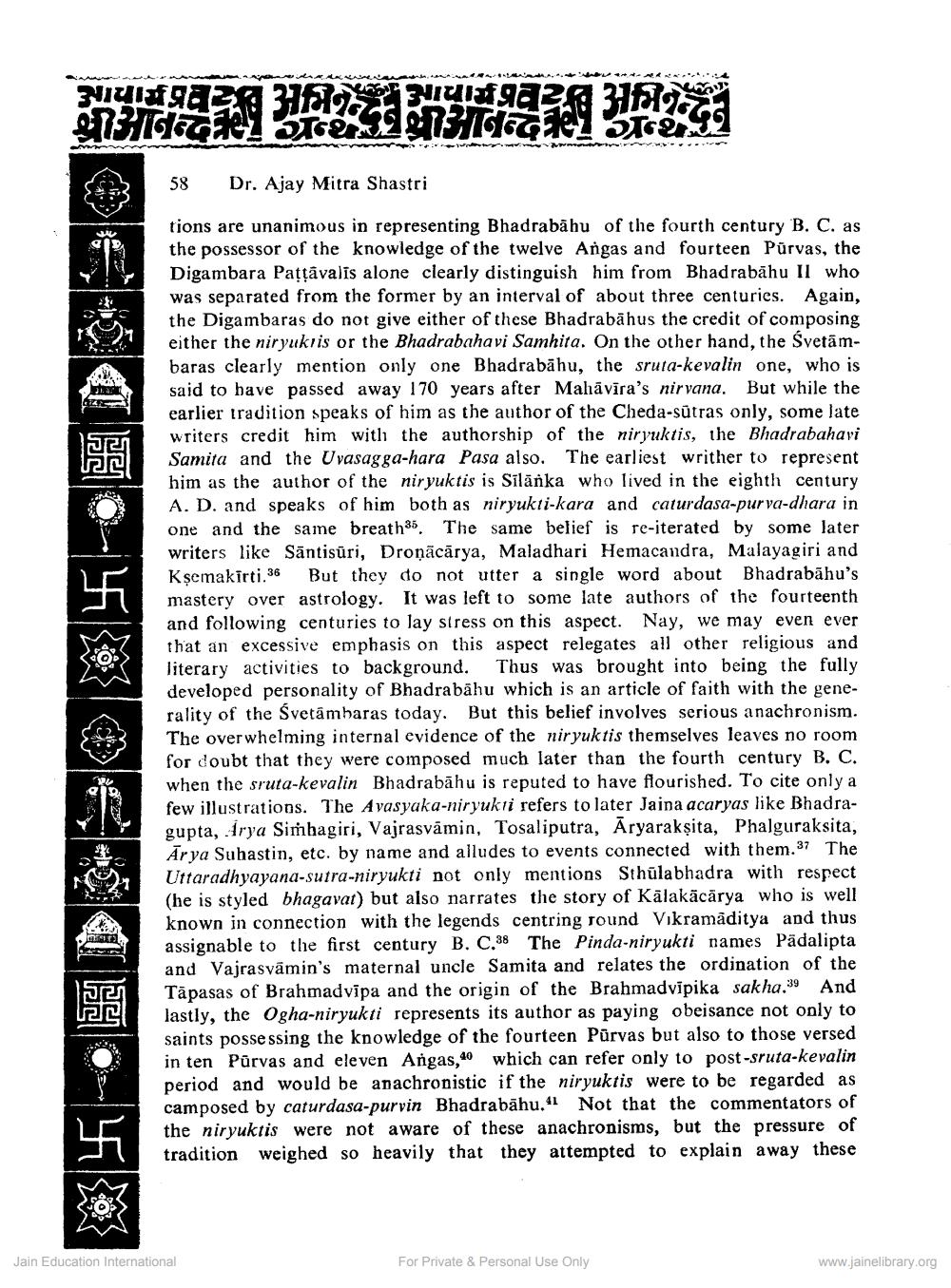Book Title: Varahamihira and Bhadrabahu Author(s): Ajay Mitra Shastri Publisher: Z_Anandrushi_Abhinandan_Granth_012013.pdf View full book textPage 7
________________ ziy90273 Buigaz, 3100 SISe Streng13 Tegetely 518 58 Dr. Ajay Mitra Shastri tions are unanimous in representing Bhadrabāhu of the fourth century B. C. as the possessor of the knowledge of the twelve Angas and fourteen Purvas, the Digambara Pațţāvalīs alone clearly distinguish him from Bhadrabāhu II who was separated from the former by an interval of about three centuries. Again, the Digambaras do not give either of these Bhadrabähus the credit of composing either the niryukris or the Bhadrabahavi Samhita. On the other hand, the Svetāmbaras clearly mention only one Bhadrabāhu, the sruta-kevalin one, who is said to have passed away 170 years after Mahāvīra's nirvana. But while the earlier tradition speaks of him as the author of the Cheda-sūtras only, some late writers credit him with the authorship of the niryuktis, the Bhadrabahavi Samita and the Uvasagga-hara Pasa also. The earliest writher to represent him as the author of the niryuktis is Silanka who lived in the eighth century A. D. and speaks of him both as niryukti-kara and caturdasa-purva-dhara in one and the same breath35. The same belief is re-iterated by some later writers like Sāntisūri, Droņācārya, Maladhari Hemacandra, Malayagiri and Ksemakirti.36 But they do not utter a single word about Bhadrabāhu's mastery over astrology. It was left to some late authors of the fourteenth and following centuries to lay stress on this aspect. Nay, we may even ever that an excessive emphasis on this aspect relegates all other religious and literary activities to background. Thus was brought into being the fully developed personality of Bhadrabāhu which is an article of faith with the generality of the Svetāmharas today. But this belief involves serious anachronism. The overwhelming internal evidence of the niryuktis themselves leaves no room for doubt that they were composed much later than the fourth century B. C. when the sruta-kevalin Bhadrabāhu is reputed to have flourished. To cite only a few illustrations. The Avasyaka-niryukri refers to later Jaina acaryas like Bhadragupta, Arya Simhagiri, Vajrasvāmin, Tosaliputra, Āryarakṣita, Phalguraksita, Arya Suhastin, etc. by name and alludes to events connected with them.37 The Uttaradhyayana-sutra-niryukti not only mentions Sthūlabhadra with respect (he is styled bhagavat) but also narrates the story of Kälakācārya who is well known in connection with the legends centring round Vikramaditya and thus assignable to the first century B. C.38 The Pinda-niryukti names Pädalipta and Vajrasvämin's maternal uncle Samita and relates the ordination of the Tāpasas of Brahmadvipa and the origin of the Brahmadvipika sakha.39 And lastly, the Ogha-niryukti represents its author as paying obeisance not only to saints possessing the knowledge of the fourteen Purvas but also to those versed in ten Purvas and eleven Angas, 40 which can refer only to post-sruta-kevalin period and would be anachronistic if the niryuktis were to be regarded as camposed by caturdasa-purvin Bhadrabāhu. Not that the commentators of the niryuktis were not aware of these anachronisms, but the pressure of tradition weighed so heavily that they attempted to explain away these Jain Education International For Private & Personal Use Only www.jainelibrary.orgPage Navigation
1 ... 5 6 7 8 9 10 11 12 13 14 15 16 17 18 19 20
